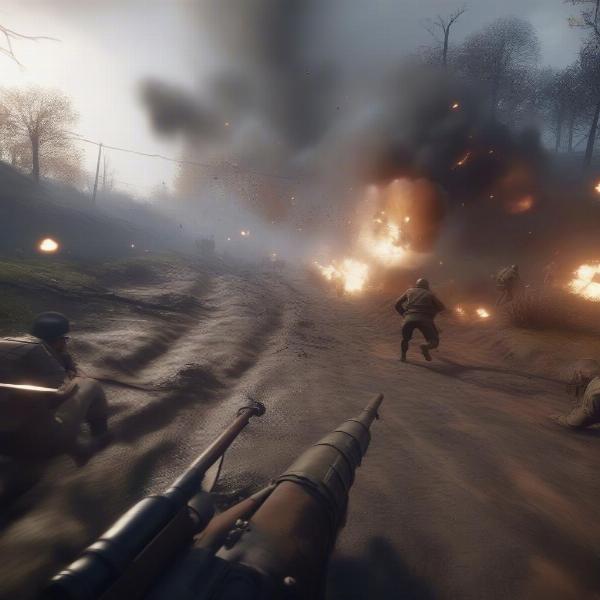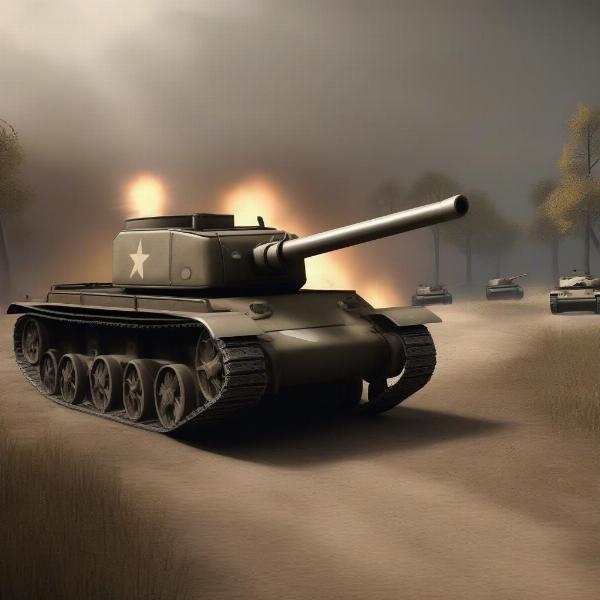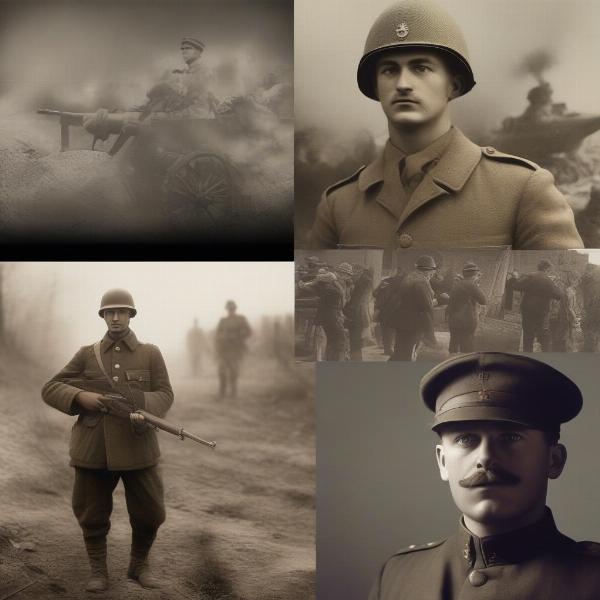World War 1, a conflict of unprecedented scale and brutality, has offered a compelling backdrop for numerous video games. Here at supremeduelist.blog, we explore how these games tackle the complex realities of trench warfare, technological advancements, and the human cost of the Great War. This analysis delves into different gaming approaches, from intense shooters to strategic simulations, and evaluates how well they capture the historical context. We’ll discuss the impact of these games on our understanding of the war and their effectiveness in creating engaging and thought-provoking experiences.
The immersive potential of video games offers a unique lens through which to examine historical events, and the First World War is no exception. This article will dissect several titles that have attempted to recreate the atmosphere and challenges of this era. By examining their gameplay mechanics, narrative choices, and overall presentation, we can gain a deeper appreciation for the complexity of recreating this conflict in an interactive medium. Furthermore, we’ll explore how these games help or hinder our understanding of the past. Let’s explore the best World War 1 Video Games.
The Battlefield Experience: From Shooters to Strategy
One of the most common approaches to world war 1 video games is through the lens of first-person shooters. Games like Battlefield 1 have attempted to portray the chaos and scale of the war, putting players directly into the muddy trenches and large-scale battles. These games often focus on intense action, emphasizing the use of period-accurate weapons and vehicles. However, they sometimes sacrifice historical accuracy for the sake of entertainment, presenting a more romanticized or simplified view of the conflict.
 first-person-shooter-game-battlefield-1-focusing-intense-action
first-person-shooter-game-battlefield-1-focusing-intense-action
Beyond the action-packed gameplay of first-person shooters, there exists a subset of world war 1 video games focused on strategy and management. Titles in the strategy genre emphasize the logistical and tactical aspects of the war. Players often take on the role of a commander, making decisions that impact the war’s outcome. These games might involve managing resources, deploying troops, and developing new technologies, offering a broader perspective on the conflict’s intricacies. It’s interesting to consider how these different game types appeal to distinct player types.
What are the Key Elements of World War 1 Games?
Effective world war 1 video games often include features that emphasize the unique aspects of the conflict. The trench warfare system is a big factor; many games attempt to replicate the claustrophobic, brutal, and static nature of battles. Additionally, the use of chemical weapons, early tanks, and biplanes are often crucial parts of the experience, highlighting the technological changes and devastating new forms of combat during the war. As Dr. Emily Carter, a historian specializing in conflict analysis, remarks, “The best games allow players to engage with the challenges of the era through immersive mechanics.” These factors combine to provide players a unique gaming experience.
A crucial element to many world war 1 video games is the depiction of the sheer human cost of the conflict. The emotional toll on soldiers and civilians alike is explored in some narratives, often using individual character stories within the context of the large-scale war. This helps humanize the historical event and offers a deeper appreciation of the sacrifices made. The stark contrast between the romanticized notions of war and the grim realities of the trenches often forms a key aspect of gameplay and narrative design in these games, creating powerful experiences that resonate with players. In the same way, ps5 game the lives of war explores the experiences of individuals during a different conflict, focusing on personal narratives of soldiers and civilians.
Historical Accuracy vs. Gameplay: Finding a Balance
The challenge for developers of world war 1 video games lies in balancing historical accuracy with engaging gameplay. While striving for authenticity, game designers must make certain concessions to create a fun and accessible experience. Some games prioritize historical details, presenting weapons, uniforms, and tactics that are as accurate as possible. Others focus on crafting an engaging and action-packed experience, sometimes bending or ignoring historical facts for the sake of gameplay.
 world-war-1-game-feature-early-tanks-accuracy-vs-fun
world-war-1-game-feature-early-tanks-accuracy-vs-fun
The debate about accuracy versus fun is not new to the gaming world. Similar challenges are often found in recreating other periods and conflicts, such as the best ps2 star wars games which must balance the source material with enjoyable mechanics and game play. The most successful games often manage to strike a balance that both educates and entertains, creating an interactive experience that’s both engaging and thought-provoking. This balance usually allows for players to enjoy a game while also gaining a little knowledge in the process.
Are World War 1 Games Educational?
The educational value of world war 1 video games is often debated. While games may introduce players to historical events, they often present an abbreviated and sometimes biased version of history. Many players may gain a basic understanding of the conflict from these games, but these can’t replace the in-depth study of historical texts and primary sources. The key is in not taking these games as the sole source of information, but rather as a starting point to stimulate curiosity and further research.
The fog of war in games, as discussed in our article on fog of war in games, is a common gaming mechanic. In the context of world war 1 video games, this mechanic often simulates the uncertainty and chaos of battle, but it is also a way to limit player visibility on the map to replicate the tactical challenge of warfare. From a player experience perspective, this fog of war enhances gameplay. However, from an educational perspective, it’s crucial to understand that the fog of war can misrepresent the real experience of the conflict by obscuring a bigger picture.
The Impact of World War 1 Games on Our Understanding
World war 1 video games, regardless of their level of historical accuracy, play a role in shaping public perception of the conflict. These games can bring the historical period to a younger audience in ways that traditional methods of learning sometimes cannot. Playing these games can help create a sense of empathy by putting players in the shoes of soldiers or commanders. They offer an engaging entry point for people interested in history, making complex events more accessible. This has both advantages and disadvantages; the potential for biased interpretations of history is still very prevalent.
 world-war-1-game-impact-perception-of-history
world-war-1-game-impact-perception-of-history
However, it is crucial to approach these games with a critical eye. As Professor Alan Davies, an expert in digital history notes, “Games are interpretations of the past, not replications of it.” The narratives and gameplay mechanics are often created with specific purposes in mind, and they should not be taken as the sole or definitive truth about the war. These games also tend to focus on the military aspects of the war, overlooking the social, political, and economic factors that contributed to it. Nevertheless, they remain a valuable entry point for learning about the past.
What are some lesser-known World War 1 games?
While some well-known titles dominate the landscape of world war 1 video games, there are also several lesser-known games worth exploring. Indie titles often present unique approaches to the conflict, offering a more intimate and focused view. Some emphasize character stories and moral dilemmas, while others highlight specific aspects of the war, such as the use of specific weaponry or the experiences of different nationalities. These hidden gems can offer a new understanding of the conflict.
Just as phineas ferb star wars game offers a lighthearted interpretation of a well-known theme, some less mainstream world war 1 video games offer a unique perspective on the topic by straying from the main themes of large-scale conflict and action. Games that take this approach, even in other genres, can provide new insights on themes that are usually overlooked by games.
Conclusion: Engaging with History Through Games
World war 1 video games offer a unique and engaging way to interact with history. They provide immersive experiences that allow players to participate in events that occurred more than a century ago. Although they often sacrifice some historical accuracy for the sake of entertainment, these games can stimulate interest in the First World War and encourage further exploration of the historical period. However, it is critical to approach them critically, understanding that they are just one interpretation of a vast and complicated event.
Here at supremeduelist.blog, we encourage you to try out different types of these games and find one that sparks an interest in the period for you. By engaging with these games thoughtfully, you will gain new perspectives on the past and understand both the historical setting and the art of game design. Discovering these games, and all of their intricacies, will definitely enhance your understanding of the conflict. Don’t hesitate to explore our other articles for more detailed analysis of various gaming genres and historical themes.
Leave a Reply